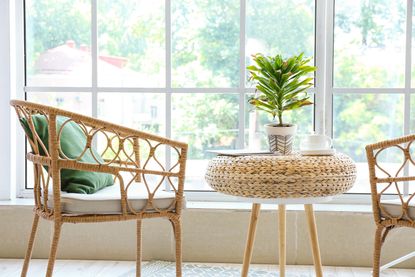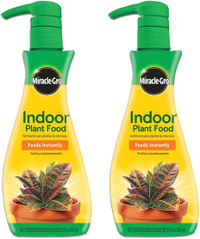Calling all Plant Parents - do you love them too much?! The 6 signs of over-fertilized houseplants you're mistaking for something else
It's easy to mistake the signs of over-fertilization for a lack of nutrients, leading us to worsen the issue with more fertilizer


Are you overfertilizing your houseplants? The answer probably isn't clear-cut. Signs of overfertilization aren't always easy to spot and can easily be confused for something else. Worse still, so many of us worry about neglecting our plant babies that we actually swing so far the other way that we end up loving them to death, quite literally.
If you're a plant parent, you'll know that fertilizing your plants during the growing season is the best way to keep them thriving and looking their best. For the less green-thumbed among us, the thought of a miracle formula that promises to keep houseplants healthy is also an appealing one. And yet, what many of us don't realize is that overfertilizing your plants can cause just as much harm as forgetting to water them.
As tempting as it might be to up your fertilizer dose if your houseplant's seen better days, you should resist the temptation to avoid risking overfertilization. In fact, you may even mistakenly identify the signs of an overfertilized plant as a lack of fertilizer, worsening the issue even more. To keep you decorating with plants that look vibrant and happy, we caught up with a plant expert who shares the tell-tale signs of overfertilized houseplants below.

Lilith is an expert at following news and trends across the world of interior design. She regularly shares simple solutions to help brighten our homes, a personal favorite of hers being houseplants. For this piece, she spoke with plant experts to learn the tell-tale signs of over-fertilized plants that we need to look out for
1. Fertilizer burns

Ever noticed your houseplant's leaves turn brown and dry at the edges? It's easy to mistake this sign for a thirsty plant, but experts say it's actually more likely to be the result of fertilizer burn.
'Overfertilization can cause leaves to burn at the tips or edges,' explains Richa Kedia, houseplant expert at Simplify Plants. 'It's often caused by excess salts in the soil, which can accumulate when too much fertilizer is applied. When the salt concentration in the soil is too high, it can cause water stress in the plant, leading to leaf discoloration.' Try fertilizing your houseplants naturally with waste products like banana peels or eggshells to result the risk of fertilizer burn.
2. Leggy growth

As with most symptoms of poor health in plants, there are many possible reasons why your plant is looking a bit leggy. With certain plants such as succulents, it's often simply a case that your plant is more mature, or, it could be that it's receiving insufficient light and is therefore growing longer stems in a search for sun. It can however also be a sign of overfertilization.
'Overfertilization also contributes to leggy growth by causing the plant to focus on foliage at the expense of root growth,' Richa explains. 'It can lead to a weaker root system, making it difficult for the plant to support a strong, healthy stem.' If you think a lack of light could be the cause, move your plant to a sunnier spot. If the problem persists, it's time to assess your fertilizing regime.

Miracle-Gro Indoor Plant Food, Amazon
If you're looking for an easy-to-use indoor plant food, Miracle-Gro is a safe bet. This pack of two bottles of plant feed from Amazon is suitable for all indoor plants, including edibles, and can be applied directly to the soil or mixed with water.
3. Yellow and brown leaves

In most cases, yellowing leaves on your houseplant are likely to be due to overwatering or a deficiency in nutrients such as potassium, but it can also be an indicator of too much fertilizer.
As Richa notes: 'Excess fertilizer can damage the roots of the plants, which prevents the plant from absorbing nutrients properly, leading to nutrient deficiencies.' Check whether your watering regime is in line with your plant's needs. If the soil doesn't feel waterlogged, there's a high chance you've been overfertilizing.
A potassium deficiency won't occur if you've been fertilizing either, so this should be easy to rule out, but the best natural way to boost potassium levels and improve leaf health is by feeding your plants with leftover potato water (as long as it's not salty).
4. Wilting or drooping of leaves

We've all had houseplants that have struggled with wilting or drooping leaves, no matter how strict we are with our watering regime. If you've been monitoring your plant too closely and giving it too much care in the form of a fertilizer, you might want to hold back on the supplements for some time.
'Overfertilization can cause wilting in houseplants, even if the soil is moist,' Richa says. 'It's often due to root damage, which makes it difficult for the plant to absorb water from the soil.' As she explains, when the roots of a plant are damaged, they may no longer be able to take up water quickly enough to support the plant, leading to drooping and wilting of leaves as a result.
5. Salt build-up

Ever noticed a crusty white substance on your plant's leaves or around the edges of the topsoil? Well, those are actually mineral deposits, mostly salt, and they can be a sign you've been too heavy-handed with the fertilizer.
'When you apply fertilizer to your houseplants, the salts in the fertilizer dissolve in water and are taken up by the plant roots,' Richa explains. 'However, applying too much fertilizer can build up excess salts in the soil.'
As the salt concentration in the soil increases, it can make it more difficult for the plant to absorb water from the soil. 'That happens because the salt concentration outside the plant roots is higher than the concentration inside the roots, which can cause water to move out of the roots and into the soil,' Richa adds. 'It can also lead to water stress in the plant, which can cause the plant to wilt and even lead to root damage.'
Mineral deposits can also build up in your soil just from watering with tap water. Try using filtered water or try bottom watering your plants to reduce the risk.
6. Loss of leaves

It's normal for houseplants to lose a few leaves as they mature, or as a result of external factors like the temperature or being in a high-traffic area. If you're noticing that your plant's suddenly losing a lot more leaves than usual, however, overfertilization could be the cause.
As Richa explains, it primarily happens due to root damage, which can make it difficult for the plant to absorb water and nutrients from the soil. 'As a result, the plant goes into survival mode and begins to shed leaves to conserve energy,' she says. Applying crushed eggshells as a natural fertilizer is a much safer way to get your plant's roots the nutrients they need without running the risk of damage.
How to save overfertilized houseplants
If you're noticing signs of overfertilization, all is not lost. You can easily reverse the effects by cutting back on fertilizing and giving your plants some extra TLC.
1. Stop fertilizing
Intuitively, the first thing you should do if you've been using a lot of fertilizer and notice any of the symptoms above is to stop supplementing your plant immediately. This will prevent any further damage to the roots and leaves.
2. Flush the soil
It's a good idea to also flush your plant's soil to help to remove excess fertilizer and any salts or mineral deposits that may have built up in the soil. 'To do this, water the plant thoroughly until water runs out of the drainage holes,' says Richa. 'Repeat this process several times for a few days, ensuring the soil and pot have adequate drainage else this process may backfire.'
If your soil is looking worse for wear and your plant is really struggling, you might want to completely re-pot it. 'This can help remove excess fertilizer and give the plant a fresh start,' Richa adds.
3. Trim any damaged leaves or stems
'If the plant leaves are severely damaged, you may need to trim them to promote new growth,' notes Richa. Use a pair of scissors or secateurs to carefully remove any dead leaves or wilting stems so that the plant can direct all its energy to regrowth.
'After taking these steps, monitor the plant closely to ensure that the plant is recovering,' says Richa. 'Be sure to water the plant only when the soil is dry to the touch, and avoid fertilizing for at least a few months.'
Be The First To Know
The Livingetc newsletter is your shortcut to the now and the next in home design. Subscribe today to receive a stunning free 200-page book of the best homes from around the world.

Lilith Hudson is the News Editor at Livingetc, and an expert at decoding trends and reporting on them as they happen. Writing news, features, and explainers for our digital platform, she's the go-to person for all the latest micro-trends, interior hacks, and color inspiration you need in your home. Lilith discovered a love for lifestyle journalism during her BA in English and Philosophy at the University of Nottingham where she spent more time writing for her student magazine than she did studying. After graduating, she decided to take things a step further and now holds an MA in Magazine Journalism from City, University of London, with previous experience at the Saturday Times Magazine, Evening Standard, DJ Mag, and The Simple Things Magazine. At weekends you'll find her renovating a tiny one-up, one-down annex next to her Dad's holiday cottage in the Derbyshire dales where she applies all the latest design ideas she's picked up through the week.
-
 These 12 Best Table Lamps for Your Desk — Perfect Glows for a Creative Home Office
These 12 Best Table Lamps for Your Desk — Perfect Glows for a Creative Home OfficeThe best table lamps for your desk is have a soft, targeted glow. Elevate your WFH set-up with these stylish picks endorsed by Style Editor Brigid Kennedy
By Brigid Kennedy Published
-
 The Nespresso VertuoPlus is 30% Off for President's Day, and it's Kim Kardashian's Coffee Maker of Choice
The Nespresso VertuoPlus is 30% Off for President's Day, and it's Kim Kardashian's Coffee Maker of ChoiceThis sleek and stylish coffee maker was spotted in Kim's home bar, and you can currently save $60 if you buy yours from Amazon
By Lilith Hudson Published

